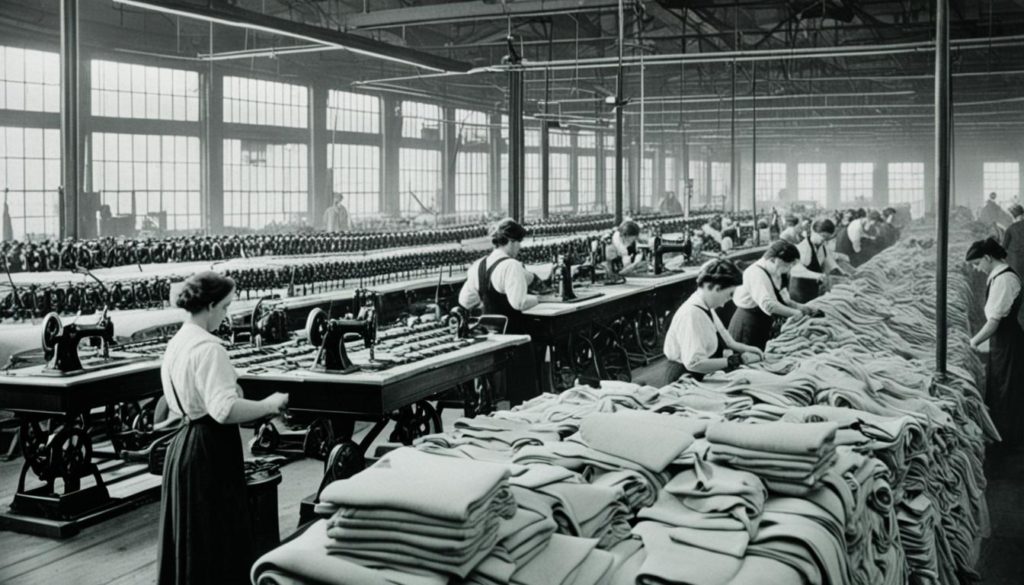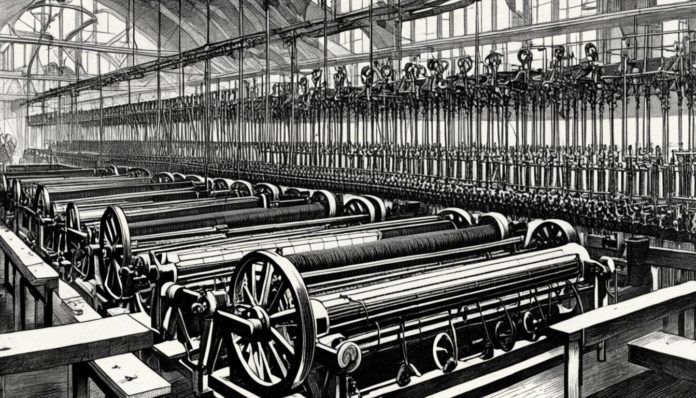The 19th century was a time of big changes in fashion, thanks to the industrial revolution. This era brought new ways of making textiles and ready-to-wear clothes. It also introduced new fashion trends for the growing middle class. As the world changed fast, how people dressed and got fashion changed a lot, changing the fashion industry forever.
Key Takeaways
- The Industrial Revolution ushered in a new era of textile manufacturing, marked by advancements in weaving and spinning technologies.
- The emergence of ready-to-wear clothing made fashion more accessible to the growing middle class.
- Changing fashion trends catered to the evolving preferences and lifestyles of the industrialized society.
- Urbanization and the garment industry led to the rise of sweatshops and challenging labor conditions.
- Fashion became a symbol of status and social class as the Industrial Revolution reshaped the economic landscape.
Textile Revolution and Mass Production
The 19th century was a big change for the textile industry. New machines for weaving and spinning fabrics changed everything. These machines made making fabrics faster and let for more fabrics, from silk to cotton.
Advancements in Weaving and Spinning
The Industrial Revolution brought big changes to textiles. The power loom and spinning machines made making fabric on a large scale possible. This made making clothes cheaper and easier.
Rise of Ready-to-Wear Clothing
Ready-to-wear clothing became popular in the 19th century. Before, clothes were made just for the rich. But with mass production, more people could afford stylish clothes. This changed fashion for everyone.
| Technological Advancement | Impact on Textile Manufacturing |
|---|---|
| Power Loom | Increased production efficiency and fabric variety |
| Mechanized Spinning | Streamlined the yarn-making process for mass production |
| Standardization of Clothing Sizes | Enabled the rise of ready-to-wear fashion for the middle class |
“The industrial revolution transformed the textile industry, empowering the middle class with access to fashionable apparel.”
Emergence of the Middle Class
The 19th century saw a big change in society, with a strong middle class rising. This group, boosted by industrial growth, had more money and wanted fashionable clothes.
As more people joined the middle class, they wanted stylish clothes. Designers and makers quickly noticed this and changed their focus. They started making clothes that anyone could buy, not just the rich.
This change was huge for fashion in the 19th century. Clothes that were once only for the rich became popular with the middle class. This changed how people saw fashion and broke down old social barriers.
The middle class made fashion more open to everyone. It also made the fashion world more creative and innovative. Companies tried to meet the needs of this new group by offering many styles and fabrics.
| Characteristic | Middle Class in the 19th Century | Upper Class in the 19th Century |
|---|---|---|
| Fashion Accessibility | Increased access to fashionable clothing | Exclusive access to haute couture |
| Fashion Trends | Embraced emerging fashion trends | Dictated fashion trends |
| Fashion Spending | Grew as a key consumer group | Remained the primary target of high-end fashion |
The middle class and their love for fashion changed the 19th-century fashion world. This shift made fashion available to more people. It also made the fashion industry more diverse and welcoming to everyone.
The Impact of Industrialization on Fashion in the 19th Century
The 19th century was a big change for fashion, thanks to industrialization. This time, 19th century fashion trends changed a lot. Designers and manufacturers used new mass production and textile technology methods.
Changing Trends and Styles
Industrialization helped bring new fashion styles fast. Designers could quickly meet what people wanted, making fashion change often. Silhouettes, fabrics, and decorations changed a lot, showing the era’s spirit.
Accessibility to Fashion
Industrialization made fashion accessible to more people. Mass production made clothes cheaper, so not just the rich could follow fashion trends. This let more people join in, making fashion more diverse and inclusive.
| Trend | Description |
|---|---|
| Crinoline Silhouette | The voluminous, bell-shaped skirt, made possible by advancements in steel-hooped petticoats, became a hallmark of mid-19th century fashion. |
| Bustle Silhouette | The late 19th century saw the rise of the bustle, a decorative feature that added volume to the back of a garment, creating a distinctive and dramatic silhouette. |
| Machine-Printed Textiles | Mechanized textile printing techniques allowed for the mass production of intricate and vibrant patterns, making fashionable fabrics more accessible to the masses. |
Industrialization changed fashion trends and accessibility in the 19th century. It made fashion more diverse and dynamic. Designers and consumers could explore new styles, shaping the fashion world.

Urbanization and the Garment Industry
The 19th century saw a big change with the growth of the garment industry. Many factories moved to cities. This led to the rise of sweatshops, where workers had bad working conditions and were treated unfairly.
Sweatshops and Labor Conditions
Urban growth was linked to the growth of the fashion manufacturing industry. To make more clothes cheaply, factories used bad labor practices. They set up sweatshops where workers worked long hours in bad conditions for little pay.
This had big social and economic effects on the 19th century garment industry. Workers, including women and kids, were treated unfairly. They faced poor safety and had few rights. Owners cared more about making money than their workers’ health.
“The conditions in which these workers toiled were truly appalling, a stark contrast to the fashionable garments they produced.”
The rise of sweatshops and worker exploitation became a big issue. It made people call for better labor laws in the fashion manufacturing world of the 19th century.

Fashion as a Symbol of Status
In the 19th century, fashion became a key way to show social status and class. Mass-produced, affordable clothes let the growing middle class copy the styles of the rich. This changed how people showed their social level and helped shape fashion trends during the industrial revolution.
As time went on, the middle class could easily get the latest fashion thanks to ready-to-wear clothes. This gave people a way to show their social status and dreams through what they wore. Dressing like the upper class was a way for the middle class to show their growing wealth and influence.
The relationship between fashion, social status, and class in the 19th century was complex. Fashion didn’t just show social changes; it helped create them. People used their clothes to find their place in society and move up the social ladder.
